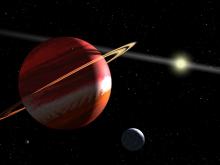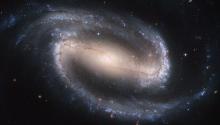Listen to today's episode of StarDate on the web the same day it airs in high-quality streaming audio without any extra ads or announcements. Choose a $8 one-month pass, or listen every day for a year for just $30.
You are here
Epsilon Eridani
Frank Drake picked two target stars for Project Ozma, the first search for extraterrestrial intelligence. The first to be scanned was Tau Ceti. And the second was Epsilon Eridani, a close neighbor — just 10 and a half light-years away.
It turns out, though, that Epsilon Eridani probably isn’t a good place to look for life. The star is young, so there hasn’t been much time for life to take hold. It probably produces a lot of ultraviolet and X-ray energy, which is dangerous. And its planets may face a steady barrage of space rocks.
Epsilon Eridani is a little smaller and less massive than the Sun, and just a third as bright. Most studies say it’s between 200 million and 800 million years old, which is quite young. Because of its youth, it spins rapidly — about twice as fast as the Sun does. That generates a strong magnetic field. The field creates big outbursts that would shower planets with deadly radiation.
Astronomers have discovered two possible planets in the system. But they’re bracketed by asteroid belts and a big “doughnut” of rocks and dust. Many of those space rocks fall toward the star. Some of them slam into the planets — making conditions especially hard for life.
Project Ozma found no signals from Epsilon Eridani when it scanned the system with a radio telescope in 1960. And Drake repeated the observations 10 years ago — again coming up empty. So there’s no hint of a civilization in this messy star system.
Script by Damond Benningfield




